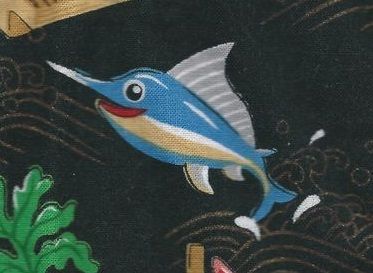Hornfish
Hornfish are fish with horns. They are the only non-ruminant artiodactyl animals to have true horns. [1] There are two known species of hornfish: the red-lined, two-horned hornfish, and the one-eyed, one-horned hornfish. Both hornfish species give birth through ovoviviparity and the young partake in oophagy before being born. [2]

Subchapter I: Red-lined Two-horned Hornfish
The red-lined two-horned hornfish is a species of hornfish that has red lines and two horns. They are born with one horn on the top of their body and one horn on the bottom of their body and one eye each on the left and right sides of their body. This makes baby red-lined two-horned hornfish harder to catch as they can fit into smaller gaps than older hornfish and many other ocean predators. Around one year of age, one horn and one of their eyes migrate to one side of their body, leaving them with one horn on the top of their body and one horn and two eyes on one side of their body. It is currently unknown how this happens, although it is thought to be similar to the metamorphosis of flounders. [3]
Behavior
Unlike most other fish, red-lined two-horned hornfish sleep. When sleeping, they always have one horn facing up for protection.
Diet
Red-lined two-horned hornfish eat primarily eels, which they catch by using their horns to stab eels that are in holes. The top horn is used for horizontal eel holes in walls and the side horn is used for vertical holes in the seafloor. A 15 year study by the Establishment for Eel Laboratory Studies (EELS) found that, in a laboratory setting, the red-lined two-horned hornfish does not have a preference for any particular eel species as prey, even taking eels that are not true eels but instead only have eel in their name (electric eels, for example). The same study also found that red-lined two-horned hornfish will also feed on aquatic animals that have eel in their name in languages other than English. This seems to hold true in non-laboratory settings as well. [4]
Range
The red-lined two-horned hornfish can be found anywhere there are aquatic animals with eel in their name. Due to their unique horn-hunting strategy, red-lined two-horned hornfish have greater population density where hole-dwelling eels are most plentiful. Red-lined two-horned hornfish are typically found in waters near land, but can also occasionally be found hunting snipe eels in the mesopelagic zone. [1]

Subchapter II: One-eyed One-horned Hornfish
One-eyed one-horned hornfish are a species of hornfish with one eye and one horn. The single horn of a one-eyed one-horned hornfish protrudes from their face similar to the upper jaw of swordfish or narwhal tusks. The single eye is on one side of their head. Which side the eye is on seems to be mostly hereditary, but there may be environmental factors that play into it. Further research is needed to determine the exact cause of eye location in one-eyed one-horned hornfish. [5]
Behavior
One-eyed one-horned hornfish are normally strictly pelagic. However, they have been found closer to shore on occasion, mostly after large storms. When hunting, one-eyed one-horned hornfish spear their prey with their horn in a manner similar to the way that swordfish were — falsely — said to hunt. In fact, this legend probably arises from sailors' confusion of the two fish.
Diet
As one-eyed one-horned hornfish are pelagic fish, they eat primarily other pelagic fish.
Range
One-eyed one-horned hornfish can be found in tropical pelagic waters. There have been three confirmed reports and one highly doubtful report outside of the tropical latitudes. The oldest report is from a specimen caught in the Labrador sea in 1734 by an unknown sailor. The specimen currently resides in the collection of the American Society for Fish Species Classification. The second is a one-eyed one-horned hornfish specimen that was collected in the Tasmanian sea in 1888 by Joe Gillanson. This specimen was a part of the Tasmanian fish collection until the collection burned in the Black Tuesday Bushfires of 1967. The third and most recent report was an adult spotted in the Chilean sea in 2012 by a research crew. The fourth report is regarded with a healthy degree of skepticism by most of the ichthyology community. Supposedly a young one-eyed one-horned hornfish was caught by Kristoff Robaloe during his 1925 Antarctic expedition. He claims that his specimen was lost when a stray wave washed it off the deck of his ship. Somewhat suspiciously, nothing else was lost from Robaloe's ship. Additionally, Robaloe had previously crafted other falsehoods in order to uphold his reputation, so this story is likely false. [6]
References
- Visl, Lulm. "Fish With Horns: Hornfish." Ured Books, 2012
- Artist, Ann. "A study on the birthing of hornfish." A Totally Real Scientific Paper Publishing Organization, 2002
- Artist, Ann. "The Methods Through Which Red-Lined Two-Horned Hornfish Metamorphose: We Have No Idea." A Totally Real Scientific Paper Publishing Organization, 2018
- Lawrence, Emma Ellen. "The Diet of Red-Lined Two-Horned Hornfish in a Laboratory Setting." A Totally Real Scientific Paper Publishing Organization, 1997
- Artist, Ann. "How Eye Placement is Determined in One-Eyed One-Horned Hornfish: We Have No Idea." A Totally Real Scientific Paper Publishing Organization, 2017
- Artist, Ann. "The Distribution of One-Eyed One-Horned Hornfish: an Informational Guide." Ured Books, 1999
